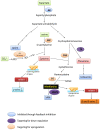Genetic and molecular understanding for the development of methionine-rich maize: a holistic approach
- PMID: 37794928
- PMCID: PMC10546030
- DOI: 10.3389/fpls.2023.1249230
Genetic and molecular understanding for the development of methionine-rich maize: a holistic approach
Abstract
Maize (Zea mays) is the most important coarse cereal utilized as a major energy source for animal feed and humans. However, maize grains are deficient in methionine, an essential amino acid required for proper growth and development. Synthetic methionine has been used in animal feed, which is costlier and leads to adverse health effects on end-users. Bio-fortification of maize for methionine is, therefore, the most sustainable and environmental friendly approach. The zein proteins are responsible for methionine deposition in the form of δ-zein, which are major seed storage proteins of maize kernel. The present review summarizes various aspects of methionine including its importance and requirement for different subjects, its role in animal growth and performance, regulation of methionine content in maize and its utilization in human food. This review gives insight into improvement strategies including the selection of natural high-methionine mutants, molecular modulation of maize seed storage proteins and target key enzymes for sulphur metabolism and its flux towards the methionine synthesis, expression of synthetic genes, modifying gene codon and promoters employing genetic engineering approaches to enhance its expression. The compiled information on methionine and essential amino acids linked Quantitative Trait Loci in maize and orthologs cereals will give insight into the hotspot-linked genomic regions across the diverse range of maize germplasm through meta-QTL studies. The detailed information about candidate genes will provide the opportunity to target specific regions for gene editing to enhance methionine content in maize. Overall, this review will be helpful for researchers to design appropriate strategies to develop high-methionine maize.
Keywords: QTLs; maize; methionine; poultry feed; sulphur metabolism; δ-zein.
Copyright © 2023 Devi, Bhushan, Gupta, Sethi, Kaur, Singh, Singh, Kumar, Rakshit and Chaudhary.
Conflict of interest statement
The authors declare that the research was conducted in the absence of any commercial or financial relationships that could be construed as a potential conflict of interest.
Figures




References
-
- Amir R. (2008). Towards improving methionine content in plants for enhanced nutritional quality. Func. Plant Sci. Biotechnol. 2, 36–46.
-
- Amir R., Tabe L. (2006). “Molecular approaches to improving plant methionine content,” in Plant genetic engineering, vol 8: metabolic engineering and molecular farming II. Eds. Pawan K. J., Jaiwal K., Rana J. (Houston, Texas: Studium Press, LLC; ), 1–26.
Publication types
LinkOut - more resources
Full Text Sources

